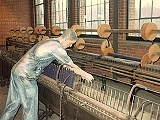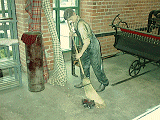
Child Labor
The system of child labor in Rhode Island mills began with Rhode Island's first textile mill - the Slater Mill. Samuel Slater's first employees were all children from seven to twelve years of age. By 1830, 55% of the mill workers in Rhode Island were children. Many of these children worked long hours in unhealthy factories for wages less than $1 per week.
 |
| Quebec Farmhouse Museum of Work and Culture |
To understand why these conditions were accepted, one must look at the attitudes and circumstances of the time. Even before the development of mills, children were expected to work long hours on self-sufficient family farms. For some poor families struggling to survive, factory work was a decided improvement over farm labor. Mills did not put children to work, they simply changed the type and location of work they were already doing.
The textile machines themselves played a large part in part in encouraging the use of child labor. Early Arkwright machines were so easy to operate that unskilled children could easily operate them. More over, centralized manufacturing with machines and children under the watchful eye of an adult overseer provided a very economical method of production.
 |
| On the Shop Floor from the Museum of Work and Culture |
Life in the mills was difficult and unhealthy, even for adults. The workday started before sunrise and ended after sunset. The air in the mills was full of flying lint particles that often caused respiratory disease. The mills were cold and drafty in winter, hot and humid in summer; dirty, noisy, and uncomfortable at all times.
During all of this, children worked under the same dismal conditions as their parents. Corporal punishment by overseers was a common practice. The danger of working near machines was always present. A tired, sleepy child could easily loss a finger, arm, or scalp to the devouring machinery.
 |
| On the Shop Floor from the Museum of Work and Culture |
At this time, childhood was not a time of formal schooling or of play, except for a wealthy minority. Most children's education, whether farm or factory, consisted of learning skills through experience. Formal education for mill children was often limited to the most basic reading, writing and arithmetic - taught at Sunday school on the child's day off. In many mill villages, these schools were also used to socialize workers along owner-approved lines.
In early mill villages, the owner alone determined the hours, earnings and physical conditions of workers. Given their ultimate control, it was not unusual for owners to take advantage of less powerful workers. While there was eventually legislation in Rhode Island against child labor, it was not effective. In 1910 only 48% of Rhode Island children attended school. In much of Rhode Island, truancy laws were often ignored. It wasn't until 1938 with the passage of the Fair Labor Standards Act that child labor was finally eliminated.
This page utilizes information from:
- History You Can See - Scenes of Change In Rhode Island 1790-1910 written by Hadassah Davis and Natalie Robinson and published by the League of Rhode Island Historical Societies, Providence, 1986.
- A History of Rhode Island Working People, edited by Paul Buhle, Scott Molloy, and Gail Sansbury and published by Regine Printing Co., Providence, 1983.
